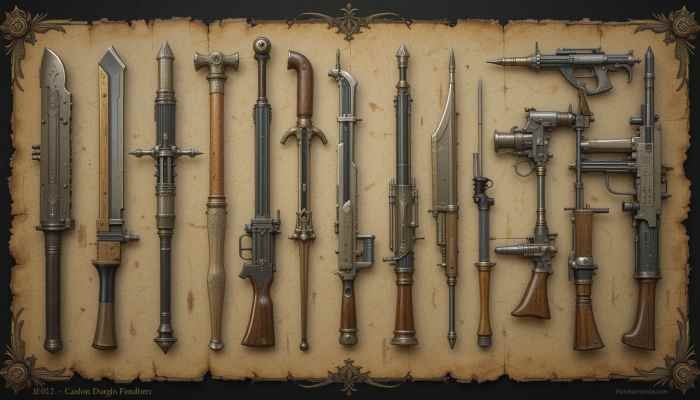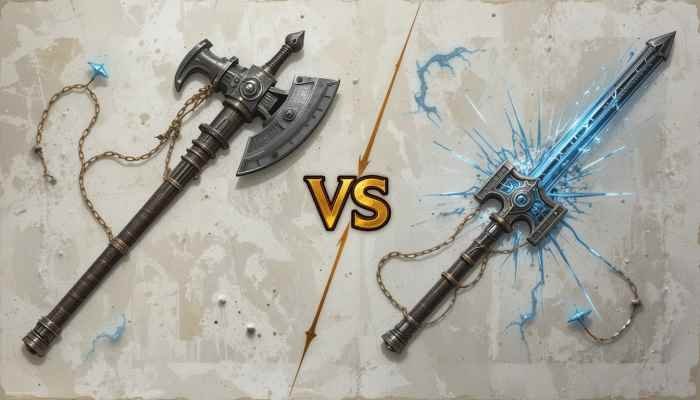Pathfinder Weapons: A Complete Guide

- Introduction to Pathfinder Weapons
- Types of Weapons in Pathfinder
- Tau Pathfinder Weapons
- Pathfinder Weapons Master
- Roll20 Pathfinder Weapons
- Pathfinder Weapons Prices
- Pathfinder Weapons and Armour
- Upgrade Pathfinder Weapons (Mass Effect Influence)
- Pathfinder Weapons Against Swarms
- Pathfinder Weapons: Mace vs Morningstar
- Pathfinder Weapons: Firearms
- Pathfinder Weapons Filter
- Pathfinder Weapons Damage
- SRD Pathfinder Weapons
- Pathfinder Weapons with Monk
- Conclusion
Introduction to Pathfinder Weapons
Pathfinder Weapons in determine how your characters will interact with the world in round-by-round encounters. The Pathfinder by Paizo system provides players_ with multiple weapons to fit various class, race, and play style permutations. The decision to pick a weapon (even a basic dagger or exotic gun, skimming the surface of this weapon pool) isn’t to be taken lightly, as it will affect combat performance and roleplaying flavour. Pathfinder has two main editions to choose from: 1st Edition (PF1e) and 2nd Edition (PF2e); each edition engineered its weapon mechanics with the weapon traits or properties, proficiencies, and damage scaling, which will dictate how your characters will carry forth in combat in your campaign.
Types of Weapons in Pathfinder
Several criteria classify weapons in Pathfinder:
- Proficiency Type: Simple, Martial, or Exotic
- Combat Role: Melee / Ranged
- Size / Handling: Light, One_Handed / Two-Handed
- Damage Type: Slashing,_ Piercing / Bludgeoning
- Special_Traits: Finesse, Reach, Agile, Deadly, etc.
From longswords to glaives_shortbows to crossbows, each category serves distinct combat strategies. Melee users often prefer heavier martial weapons_while rogues might benefit from agile finesse blades.
Tau Pathfinder Weapons
The Tau Pathfinder is a concept originating from the Warhammer 40K universe but is often conflated with Pathfinder RPG due to the shared term. While not officially part of Paizo’s Pathfinder, crossover discussions happen in homebrew or custom sci-fi Pathfinder adaptations. In such homebrew settings, Tau-style weapons might include rail rifles, pulse carbines, or ion blasters. These are typically adapted as high-damage energy weapons using Pathfinder’s advanced technology rules or the Starfinder system.
Pathfinder Weapons Master
A Weapons Master could play a thematic role and be a specific class archetype in Pathfinder. For example, in Pathfinder 1e_the Fighter could take the archetype of the Weapon Master, focusing on becoming an absolute savant with every weapon with one weapon of their choosing. The key features include the following:
- Weapon Training: Improved attack and damage rolls with chosen weapon groups.
- Weapon Mastery: Automatically confirm critical hits and increase weapon effectiveness.
- Armour Training: Retain mobility while using heavier armour.
This archetype is optimal for players who want to dominate the battlefield with raw weapon skill and mechanical precision.
Roll20 Pathfinder Weapons
Roll20 is a virtual tabletop that simplifies the use of weapons in Pathfinder by integrating automated dice rolls, character sheets, and macros. Key features include:

- Drag-and-Drop Weapons: Add weapons from the compendium directly to your character sheet.
- Automated Damage Rolls: One click triggers attack and damage, applying modifiers.
- Custom Macros: Players can script specific weapon functions for special effects or traits.
- Support for PF1e and PF2e: Different rulesets are integrated with Roll20’s system templates.
Roll20 enhances gameplay by making complex combat smoother and faster for new and veteran Pathfinder players.
Pathfinder Weapons Prices
Weapons in Pathfinder come with a wide range of prices depending on material, enchantments, and type. Here’s a breakdown:
- Simple Melee Weapons: 1–10 gp (e.g., club, dagger)
- Martial Weapons: 15–50 gp (e.g., longsword, battleaxe)
- Exotic Weapons: 75–300 gp (e.g., spiked chain, elven curve blade)
- Magical Weapons: Start at 2,000 gp and go up based on enhancement bonuses (+1 to +5) and abilities
Material upgrades (e.g., mithril, adamantine) or special traits (e.g., flaming, keen) also affect weapon prices significantly.
Pathfinder Weapons and Armour
Weapons and armour are frequently considered in tandem in Pathfinder due to encumbrance, class proficiencies, and combat synergy. Highlights include:
- Heavy Armour Fighters: Typically paired with two-handed martial weapons.
- Light Armour Rogues/Monks: Favor finesse or agile weapons.
- Spellcasters: Often wear no armor and wield simple or ranged weapons.
Armor affects movement and armor class (AC), while weapon size and type determine reach, threat range, and damage potential.
Upgrade Pathfinder Weapons (Mass Effect Influence)
Although Mass Effect is a sci-fi RPG, Pathfinder enthusiasts have occasionally adapted its upgrade path in their homebrew or hybrid games. Upgrading weapons in Pathfinder could involve:
- Runes (PF2e): Used to upgrade weapons with effects like Flaming or Striking.
- Magical Enhancements (PF1e): Add +1 to +5 bonuses and properties like Ghost Touch or Speed.
- Crafting Rules: Players can use Craft (Weapons) or Arcana skills to improve or create custom weapons.
Mass Effect-inspired upgrades could also involve integrating energy cells, scopes, or elemental enhancements using the Technology Guide or Starfinder compatibility.
Also Read: Bushnell Binoculars: Precision Optics for Every Outdoor Adventure
Pathfinder Weapons Against Swarms
Swarms in Pathfinder are notoriously tricky to handle with conventional weapons. Here‘s what works:
- Area-of-Effect Weapons: Fireballs, alchemist’s fire, or splash weapons.
- Weapons with Reach or Splash Traits: Such as nets or scatter firearms.
- Magic Weapon Traits: Flaming or shocking weapons can damage swarms if the energy is area-based.
Standard slashing and piercing weapons are typically ineffective unless the swarm has special vulnerabilities. Firearms with scatter properties are especially useful in PF2e.
Pathfinder Weapons: Mace vs Morningstar
The Mace and Morningstar may seem similar but have key differences:

- Mace:
- Damage Type: Bludgeoning
- Simple Weapon
- Typically 1d6 or 1d8 damage
- Morningstar:
- Damage Type: Bludgeoning and Piercing
- Simple Weapon
- Often more versatile due to dual damage types
Morningstars are slightly more effective in campaigns where monsters have resistance to a single damage type, making them ideal for versatility over raw power.
Pathfinder Weapons: Firearms
Firearms were introduced as part of Pathfinder’s Ultimate Combat and are treated as exotic weapons. Key traits include:
- Touch AC Attacks: In the first range increment, firearms target Touch AC, making them very accurate.
- Misfire Chance: Black powder weapons can misfire on low rolls.
- Reload Times: Flintlocks and muskets require feats or abilities to reload efficiently.
Classes like the Gunslinger specialize in firearm usage, and crafting or magical enhancement can mitigate some of the downsides of early firearms.
Pathfinder Weapons Filter
In Roll20 or online SRDs, weapon filters help narrow down options by:
- Damage Type
- Size/Weight
- Proficiency
- Weapon Traits
- Price and Availability
Using a Pathfinder weapon filter, players can sort and select weapons that match class features, desired combat roles, and campaign limitations. For example, monks might filter by “finesse” and “monk” traits only.
Pathfinder Weapons Damage
Weapon damage in Pathfinder depends on:
- Weapon Type and Size: A greataxe deals 1d12, while a dagger deals 1d4.
- Character Modifiers: Strength, dexterity (with finesse weapons), and magic bonuses.
- Traits:
- Deadly: Adds bonus dice on crits
- Fatal: Increases dice on critical hits
- Agile: Reduces multiple attack penalties
PF2e’s system allows for rune upgrades to increase base damage through Striking runes (+1dX per rune level).
SRD Pathfinder Weapons

Pathfinder’s System Reference Document (SRD) categorizes weapons by type, damage, range, and special traits. Players choose from simple, martial, or exotic weapons, each with unique benefits and restrictions based on class proficiency. Melee and ranged options include swords, axes, bows, and magical armaments. Weapon traits like finesse, reach, and versatility add tactical variety in combat. Pathfinder’s weapon system balances customization and strategy, enhancing roleplay and immersion in fantasy adventures without overwhelming complexity.
Pathfinder Weapons with Monk
Monks have a unique relationship with weapons in Pathfinder:
- Monk Weapons: Must be light, agile, or have the “monk” trait.
- Unarmed Strikes: Monks often deal more damage with fists as they level up.
- Weapon Versatility: In PF2e, monks can use weapons like bo staffs, kama, nunchaku, and shuriken without losing Flurry of Blows or other abilities.
Weapon selection is critical—wrong choices may nullify class abilities. Monks thrive when combining speed, agility, and multi-attacks with carefully chosen monk-compatible weapons.
Conclusion
Pathfinder’s weapon systems provide adventurers with robust and diverse tools. From the elementary stat block of a club to the elaborate world of enchanted firearms or the most futuristic homebrews you can devise, weapons shape a campaign’s strategy and storytelling. Whether using the Roll20 built-in mechanics, scouring the filters for the best option, or nailing down an exotic weapon accessory, knowing Pathfinder weapons is key to maximizing your character’s capabilities. Every hero, from monks to gunslingers, has a gun with a story behind it.


